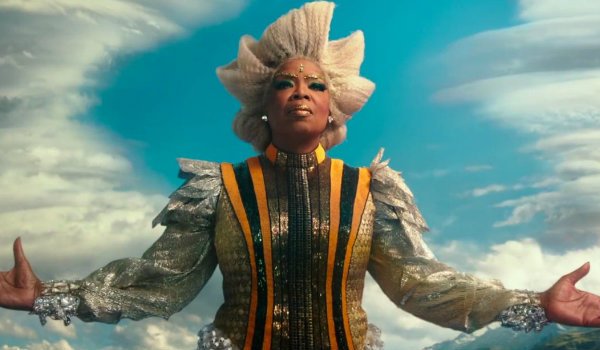Disney has shown increasing boldness in the stories that it has been willing to tell over the last few years, and now it has set its sights on one of the most iconic and challenging books ever written: Madeleine L'Engle's A Wrinkle in Time. Bringing Selma director Ava DuVernay into the equation, the film has reimagined its narrative to feel thematically relevant for the modern era, but its bright and shiny new sheen ultimately isn't enough to save it from some severe storytelling issues.
A Wrinkle in Time tells a story almost identical to that of Madeleine L'Engle's original book, albeit with a few twists. Meg Murry (Storm Reid) is a nerdy, impetuous, and misunderstood southern California girl trying to find her way in life, while also watching out for her brother Charles Wallace (Deric McCabe) and her mother (Gugu Mbatha-Raw) four years after the mysterious disappearance of her father Alex Murry (Chris Pine) during a physics experiment. Unwilling to let her father go, Meg soon stumbles into a mysterious new adventure when Charles Wallace introduces her to Mrs. Who (Mindy Kaling), Mrs. Whatsit (Reese Witherspoon), and Mrs. Which (Oprah Winfrey), three cosmic beings in search of warriors to help them find Meg's missing father. Together, along with their new friend Calvin (Levi Miller), they go on an interstellar mission to uncover the secrets of the universe, defeat a dark force threatening the cosmos, and reunite their broken family.
Once on the adventure itself, A Wrinkle in Time has a hard time staying in one place long enough to forge a connection with a setting or an environment. By its very nature, the story jumps around a lot, but it is hard not to shake the feeling that A Wrinkle in Time could use an extra 20 minutes on its runtime, so our characters can sit down and forge real bonds with one another. As it stands now, Calvin's arrival and willingness to join up with Meg and Charles Wallace comes out of nowhere, and the film's set pieces mostly boil down to Meg, her brother, and her new friend "tessering" (or teleporting) aimlessly through the cosmos. There are some great moments with characters like The Happy Medium (a surprisingly emotional Zack Galifianakis), but they are undercut by A Wrinkle in Time's hurry to get to the next set piece.
Much of this stems from A Wrinkle in Time's surprising fidelity to the book. While the look of almost everything has changed, the structure of the tale remains intact, and some pieces of dialogue are lifted wholesale. Purists will likely appreciate the faithfulness to the source material, but the structure of A Wrinkle in Time does not necessarily lend itself to the traditional three-act format of a movie. Lengthy scenes from the book (such as the cul-de-sac scene on Camazotz) are shoehorned in, but their relevance is never entirely explained in a way that enriches the overall movie.
Another element of the story that doesn't quite succeed in its transition to the screen is the establishment of conflict and stakes for A Wrinkle in Time's story. The book deals in very abstract concepts of a dark evil surging through the universe and destroying love with its negativity, but the visual portrayal of that entity (referred to as "The It") doesn't quite land in the film adaptation. A good story is ultimately only as good as its villain, but A Wrinkle in Time suffers because The It mostly looks like Parallax from Martin Campbell's Green Lantern, except it gets even less screen time to flesh out its limited personality, motivation, or intention.
One area in which A Wrinkle in Time definitely does succeed is the sheer amount of imagination and inventiveness that goes into some of its set pieces. Yes, some of the CGI work is really bad in several scenes, but there are also many sequences that take concepts from the original novel and expand upon them in some breathtaking ways. The scene in which Meg uses Mrs. Who's glasses to see at CENTRAL Central Intelligence stands out as one particularly awesome moment, and the reimagining of Red (Michael Pena) as a marionette-esque robot is another.
As for the cast, the quality of the performances has a tendency to vary. The Mrs. all have fun chewing the scenery with their respective quirks, but Oprah Winfrey is the only one who appeals to Meg on a genuinely emotional level. Among the kids, Storm Reid is the only young member of the ensemble who truly shines. Levi Miller is not given enough to do for him to leave a real impact on audiences, and Deric McCabe's Charles Wallace is one of the most gratingly annoying movie characters in recent memory. Like so many other elements from the book, the film seems to assume that audiences will pick up on the importance of these relationships, rather than take the time to show why they matter.
Out of everybody on the cast, Chris Pine is the clear standout of the bunch. He brings a level of charm, charisma, and fatherly love that warms the otherwise cold film, and the scenes that feature him tend to shine as A Wrinkle in Time's best moments. It almost leaves us wondering if Ava DuVernay would've been better off telling a looser adaptation focusing on Alex Murry's four-year journey instead of Meg's.
Despite some sharp visuals and interesting ideas, the film ultimately tells a meandering story that fails to capture the magic of the source material. Fans of A Wrinkle in Time have waited decades for a truly great adaptation of the book, but it looks like they are going to have to keep waiting.
Originally from Connecticut, Conner grew up in San Diego and graduated from Chapman University in 2014. He now lives in Los Angeles working in and around the entertainment industry and can mostly be found binging horror movies and chugging coffee.












